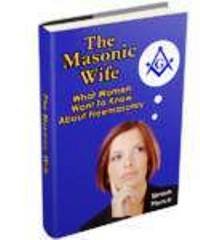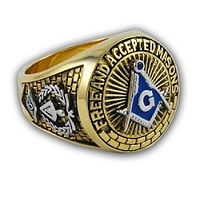Masonic Blazing Star
The Masonic Blazing Star, not to be confused with the 5-Pointed Star, is one of the most important symbols of Freemasonry.
 Masonic Blazing Star
Masonic Blazing Star
The Masonic Blazing Star makes its appearance in several of Freemasonry's Degrees.
The information, below is attributed to Mackey's
Encyclopedia of Freemasonry, 1929 in which Masonic scholars define the Masonic Star of Freemasonry.
Noted masonic scholar, Hutchinson said: “It is the first and most exalted object that demands our attention in the Lodge.”
Like many other Freemason symbols, it undoubtedly derives this importance,
first, from the repeated use that is made of it as a Masonic emblem; and second,
from its great antiquity, as a symbol derived from older systems.
Part of the Furniture of the Lodge: In the earliest monitors, immediately after the revival of
1717, the Masonic Blazing Star is not mentioned, but it was not long before it was introduced.
In the instructions of 1735, it is detailed as a part of the furniture of a Lodge, with the explanation that the “Mosaic Pavement is the Ground Floor of the Lodge, the Blazing Star, the Centre, and the Indented Tarsel,
the Border round about it!”
Star of Bethlehem: In the lectures credited to Dunckerley and adopted by the Grand Lodge, the Blazing Star was said to represent “the star which led the wise men to Bethlehem, proclaiming to mankind the nativity of the Son of God, and here conducting our spiritual progress to the Author of our redemption.”
3 Ornaments of the Lodge: In the Prestonian lecture, the Masonic Blazing Star, with the Mosaic Pavement and the Tesselated Border, are called the Ornaments of the Lodge.
The Prestonian lecture goes on to explain:
Moses on the Mount: “The Masonic Blazing Star, or glory in the center, reminds us of that awful period when the Almighty delivered the two tables of stone, containing the 10 commandments to His faithful servant, Moses on Mount Sinai, when the rays of His divine glory shone so bright that none could behold it without fear and trembling.
It also reminds us of the omnipresence of the Almighty, overshadowing us with His divine love, and dispensing His blessings
amongst us; and by its being placed in the center, it further reminds us, that wherever we may be assembled together, God is in the midst of us, seeing our actions, and observing the secret intents and movements of our hearts.”
Divine Providence
Star of Bethlehem: In the lectures taught by Webb, and very generally adopted in the United States, the Masonic Blazing Star is said to be “commemorative of the star which appeared to guide the wise men of the East to the place of our Saviour’s nativity,” and it is subsequently explained as hieroglyphically representing Divine Providence.
Prudence: In Hutchinson’s system, the Masonic Blazing Star is
considered a symbol of Prudence…for Prudence is the rule of all Virtues;
Prudence is the path which leads to every degree of propriety; Prudence is the
channel where self-approbation flows for ever; she leads us forth to worthy
actions, and as a Blazing Star, enlighteneth us through the dreary and darksome paths of this life”…(Spirit of Masonry, edition of 1775, Lecture 5, Page 111).
Back to Divine Providence: But the commemorative allusion to the Star of Bethlehem seeming to some to be objectionable, from its peculiar application to the Christian religion, at the revision of the lectures made in 1843 by the Baltimore Convention, this explanation was omitted and the allusion to Divine Providence, alone, was retained.
The Creator: The Freemasons on the Continent of Europe, speaking of
the symbol, say: “It is no matter whether the figure of which the Masonic Blazing Star
forms the center be a square, triangle, or circle, it still represents the
sacred name of God, as an universal spirit who enlivens our hearts, who purifies
our reason, who increases our knowledge, and who makes us wiser and better men.”
In the lectures revised by Doctor Hemming and adopted by the Grand Lodge of England at the Union in 1813, and now constituting the approved lectures of
that jurisdiction, we find the following definition:
The Sun: “The Blazing Star, or glory in the center, refers us to the sun, which enlightens the earth with its refulgent rays, dispensing its blessings to mankind at large and giving light and life to all things here below.”
Hence, we find that at various times the Masonic Blazing Star has been declared to be a symbol of
1. Divine Providence
2. The Star of Bethlehem
3. Prudence
4. Beauty
5. The Sun
Before we can attempt to decide upon these various opinion, and adopt the true signification, it is necessary to extend our investigations into the antiquity of the emblem, and inquire what was the meaning given to it by the nations who
first made it a symbol.
Sabaism, or worship of the stars, was one of the earliest deviations from the true system of religion. One of its causes was the universally established doctrine among the idolatrous nations of antiquity, that each star was animated
by the soul of a hero god, who had once dwelt incarnate upon earth. Hence, in the hieroglyphical system, the star denoted a god.
The Prophet Amos: To this signification, allusion is made by the prophet Amos (Amos 5:26), when he says to the Israelites, while reproaching them for their idolatrous habits: “But ye have borne the tabernacle of your Moloch and Chium, your images, the star of your god, which ye made to yourselves.”
Egyptian Idolatry: This idolatry was early learned by the Israelites from their Egyptian
taskmasters; and so unwilling were they to abandon it, that Moses found it necessary strictly to forbid the worship of anything “that is in heaven above”;
notwithstanding which we find the Jews repeatedly committing the sin which had been so expressly forbidden.
Saturn was the star to whose worship they were more particularly addicted under the names of Moloch and Chium, (already mentioned in the passage quoted from Amos).
The planet Saturn was worshiped under the names of Moloch, Malcolm or Milcom by the Ammonites, the Canaanites, the Phoenicians, and the Carthaginians, and under that of Chium by the Israelites in the desert.
Saturn was worshiped among the Egyptians under the name of Raiphan, or as it is called in the Septuagint, Remphan. (For more about the Septuagint, see
Freemasonry and the Bible.
(Acts 7:43): St. Stephen, quoting the passage of Amos, says: “ye took up the tabernacle of Moloch and the star of your god, Remphan”. (also see Acts 7:43).
Hale, in his Analysis of Chronology, says in alluding to the above
passage:
“There is no direct evidence that the Israelites worshiped the Dog-Star in the
wilderness, except this passage; but the indirect is very strong, drawn from the
general prohibition of the worship of the sun, moon and stars, to which they
must have been prone.
This was peculiarly an Egyptian idolatry, where the Dog-Star was worshiped, as
notifying by his heliacal rising, or emersion from the sun’s rays, the regular
commencement of the periodical inundation of the Nile.
The Israelite sculptures at the cemetery of Kibroth-Hattaavah, or graves of
lust, in the neighborhood of Sinai, remarkably abound in hieroglyphics of the
Dog-Star, represented as a human figure with a dog’s head.
There is express evidence that they sacrificed to the Dog-Star. In Josiah’s
description of idolatry, where the Syriac Mazaloth (improperly termed planets)
denotes the Dog-Star; in Arabic, Mazaroth.”
Notwithstanding a few discrepancies that may have occurred in the Masonic
lectures, as arranged at various periods and by different authorities, the
concurrent testimony of the ancient religions, and the hieroglyphic language,
prove that the star was a symbol of God.
It was so used by the prophets of old in their metaphorical style, and it has so
been generally adopted by Masonic instructors.
Masonic Blazing Star...As A Christian Emblem
The application of the Masonic Blazing Star as an emblem of the Savior has been made by
those writers who give a Christian explanation of our emblems, and to the
Christian Freemason, such an application will not be objectionable.
But those who desire to refrain from anything that may tend to impair the
tolerance of our system, will be disposed to embrace a more universal
explanation, which may be received alike by all the disciples of the Order,
whatever may be their peculiar religious views.
Such persons will rather accept the expression of Doctor Oliver, who,
though much disposed to give a Christian character to our Institution, says in
his Symbol of Glory, page 292, “The Great Architect of the Universe is
therefore symbolized in Freemasonry by the Blazing Star, as the Herald of our
salvation.”
Waved Pointed Star: John Guillim, the editor in 1610 of the
book A Display of Heraldrie, says: “All stars should be made with waved
points, because our eyes tremble at beholding them.”
In the early Tracing Board, the star with five straight points is superimposed
upon another of five waving points.
But the latter (five waving–points) star has now been abandoned and we have in
the representations of the present day, the incongruous (to Mackey) symbol of a
Masonic blazing star with five straight points.
Letter G: In the center of the star, there was always placed the
letter “G”,
which like the Hebrew word, “Yod”, was a recognized symbol of God, and thus the
symbolic reference of the Blazing Star to Divine Providence is greatly
strengthened."
Credit and full acknowledgement is given to Albert Mackey, Mackey’s Revised Encyclopedia of Freemasonry, Volume 1, Page 138 and 139, 1929, for the above information.
Simon-Sez: Whew! That was a long one. Sorry about that, but I felt that you deserved as full a history and the biblical relevance from the different points of view of Masonic scholars throughout history about the Masonic Blazing Star instead of a simple and trite answer that our Masonic Blazing Star is the symbol of Deity.
Freemasonry is fascinating, but rarely is it that simple.
...And Fat-Free?...only on this website. :)
I would also be remiss not to mention that within the Scottish Rite degrees
there are similar but slightly different explanations of the Masonic Blazing Star within
that organization, but that is beyond the scope of the Basic Freemasonry I
attempt to share with you, here.
For those of you who are interested, the "Fat-Free" version of the above information is below.
The Masonic Blazing star is not only a Masonic symbol, but an ancient and historic one.
From early days, Man has always looked to the heavens for guidance.
The Sun God: The sun is also a star. We
find that early man worshipped the Sun as a god. In Egypt, we find that
stars were also chosen as symbols of earthly heroes who once lived on earth and
whose spirits were immortalized in the form of a tangible (something you can
see, feel or touch) object.
The Dog Star: Egyptian idols and gravestone contain representations
of Sirius, the Dog Star. The Dog Star is actually 2 stars called Sirius A
and Sirius B.
Due to the fact that the Dog Star is 8.6 light years away, without a telescope of the magnitudinal category of the Hubble Telescope, using the naked eye, we see it as one star.
Sirius is the brightest star in the sky because it is approximately twice the size of our sun.
Heliacal Rising: The Dog Star has a heliacal rising. When the Dog Star would first become visible on the Eastern horizon approximately once a year, ancient peoples made note of it. A heliacal rising is when the star becomes visible upon the Eastern horizon at dawn, travels through the sky and "sets" in the West, much like our sun. Our sun and moon are visible for approximately 12 hours each day.
However, depending upon a star's placement in the sky, a star with a heliacal rising may appear on the Eastern horizon and slowly "rise" higher in the sky each day, until it "sets" in the West several months later.
Egyptian Calendar: The ancient Egyptians based their calendar on the heliacal rising of Sirius and devised a method of telling the time at night based on the heliacal risings of 36 stars called decan stars (one for each 10° segment of the 360° circle of the zodiac/calendar).
Agricultural Calendar: The Sumerians, the Babylonians, and the ancient Greeks also used the heliacal risings of various stars for the timing of agricultural activities.
Seafaring Travelers used the stars as a guide, much as we use a map, today.
Star of Bethlehem: For Christians, it represents God's light, ...the star of Bethlehem which guided the Wise Men to the manger whereupon they found the Son of God.
It is for that reason that the star resides at the pinnacle (the very top) of every Christmas tree, as a symbol of God's guidance.
Astronomy and Astrology: The ancients believed that the stars in the sky were connected to earthly events. Miracles were routinely associated with the birth of important people.
Hence, the study of astronomy and astrology were conceived. While many people scoff at these beliefs, today; we must also be cognizant of the deeply held belief in this system.
Halley's Comet: For those people who reject this theory completely, we must not forget that famous Freemason, Mark Twain, American author and humorist, who was born in 1835, two weeks after the closest approach to Earth of Halley's Comet.
In 1909, Mark Twain is quoted as having said:
"I came in with Halley's Comet in 1835. It is coming again next year, and I expect to go out with it." His comment was prophetic. He died in April of 1910, (age 75) one day after the comet's closest approach to Earth.
From ancient civilizations to modern man,...our Masonic Blazing Star is a symbol of
Divine Providence...the symbol of Deity which represents:
Omnipresence (the fact that the Creator is always present in our lives)
Omniscience (the fact that the Creator both sees and knows everything about us, including our thoughts and the secrets of our hearts)
...And throughout history, the Masonic Blazing Star is an ancient emblem of faith which shines for each of us, no matter which specific religion we embrace.
Related Pages:
Freemason Symbols
Masonic symbols
Masonic Emblems
Masonic Eye
5 Fast Methods To Find the Information You Want to Learn About
- Search Box - Use the Search Box at the top of your page.
- Site Map - Use my Site Map page to find the topics you are most interested in.
- Carousel - Use the carousel of pages at the top of your screen.
- Menu Icon - On MOBILE, click the MENU button at the top of each page.
- Masonic Books - Browse through a selection of Masonic books.






